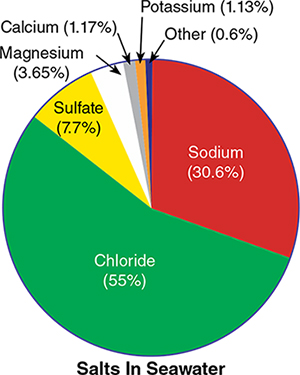
Seawater has high ionic strength. To eliminate matrix effect in measuring potassium (K+) concentration, standard solutions made with the same background as the seawater sample are recommended for calibration. The result of measurement using the LAQUAtwin Potassium Ion meter is within ±10% of typical seawater concentration.

Seawater is a complex solution of different ions with different charges. Matrix effect can be eliminated or reduced by either standard addition method or standard calibration solutions made with the same background matrix as the sample. The former technique is challenging in onsite testing.
It has been known that the composition of sea water throughout the mass of the oceans is relatively constant, and that, whatever the degree of concentration or dilution, the ratios between the concentrations of the major components vary, if at all, between narrow limits. Potassium (K) is one of the major components in seawater. The concentration is 380mg/L K+ in typical seawater.
The pocket-sized LAQUAtwin Potassium Ion meter can be used directly in seawater to measure the potassium (K+) concentration. This compact meter provides quick result with just a few drops of sample, a suitable alternative for
Calibration
Calibrate the LAQUAtwin Potassium Ion meter according to manufacturer’s instructions using two HORIBA’s standard solutions that bracket the concentration of potassium in seawater samples.
For more accurate measurement, standard solutions with the same background matrix as the sample are recommended for calibration. These solutions can be prepared as follows:
Option 1: One-point calibration with 1000ppm Potassium Standard with 2.5% NaCl. Mix 2000 ppm potassium standard solution (Y031H) and 5% NaCl solution (514-50) in 1:1 ratio. The resulting solution is 1000 ppm potassium standard with 2.5% NaCl.
Prior to calibration, set the low calibration value of the meter from 150ppm (default value) to 1000ppm. Refer to the Low. Calibration Value Setting of the meter’s instruction manual.
Option 2: Potassium Standards with synthetic ocean water background. Prepare synthetic ocean water without potassium according to ASTM D1141 to closely match the background of seawater sample. Add known amount of potassium chloride (KCl) salt to the prepared synthetic ocean water.
Example: If 2-point calibration is to be performed, prepare two standards with concentrations that are ten-fold apart (e.g., 200ppm and 2000ppm; set the low calibration value of the meter to 200ppm). To prepare standards, follow the below table or perform serial dilution (e.g., First, prepare 200ml of 2000ppm (see below table). Take 10ml from this and dilute to 100ml using synthetic ocean water. The resulting solution is 200ppm standard.)
|
Potassium Standard (K+ ppm) |
Weight of KCl (mg) per 100ml Synthetic Ocean Water |
| 150 | 28.6 |
| 200 | 38.2 |
| 1000 | 190.8 |
| 2000 | 381.6 |
Sample Measurement
Samples should be measured at the same temperature as the standard solutions used in calibration. Using the pipette that comes with the LAQUAtwin Potassium Ion meter, place a few drops of seawater sample into the sensor. Alternatively, open the slide cap of the sensor and scoop sample directly from source or container. Record the reading once stable. Rinse the sensor with DI water and blot dry with soft tissue. If the sensor response becomes sluggish, rinse the sensor with DI water and then leave a few drops of 150ppm potassium standard for a few hours. If this failed to restore the sensor response, replace the sensor.
The result of potassium determination in seawater using LAQUAtwin Potassium Ion meter and HORIBA’s standard solutions is within ±10% of typical seawater concentration. For more accurate measurement, sodium chloride (NaCl) can be used to adjust the ionic strength of a standard solution. It is the major salt component in seawater. Alternatively, prepare standard solutions that closely match the background matrix of sample. This can be accomplished by using synthetic ocean water.
Supplementary Information
Ionic strength – the quantity used to characterize the aqueous solutions that contain different concentrations of ions.
Matrix effect – the matrix, which refers to the components of the sample other than the analyte of interest, can have a considerable effect on the way the analysis is conducted and the quality of the results obtained.
Standard addition method – Measure the sample mV then add a known amounts of the standard. Record the mV values after each addition. Plot mV values (y-axis) against concentration (x-axis). Set the sample mV at 0 concentration. Extrapolate the line connecting the measured mV values to 0 mV. Read the sample concentration at the intersection of the line and x-axis.

(Source: Ocean Health - http://oceanplasma.org/documents/chemistry.html)
References And Suggested Readings
1. Test and Evaluation of Potassium Sensors in Fresh and Saltwater. United States Environment Protection Agency. March 1979
2. ASTM D1141-98 (2013) Standard Practice for the Preparation of Substitute Ocean Water. www.astm.org.
3. Richard E. Zeebe and Dieter Wolf-Gladrow. CO2 in Seawater: Equilibrium, Kinetics, Isotopes. First Edition. The Netherlands: Elsevier Science B.V., 2001
4. D.A. Webb, Ph.D. The Sodium and Potassium Content of Seawater. Department of Zoology. Cambridge University. 15 November 1938 REV 0, 2 SEPTEMBER 2015